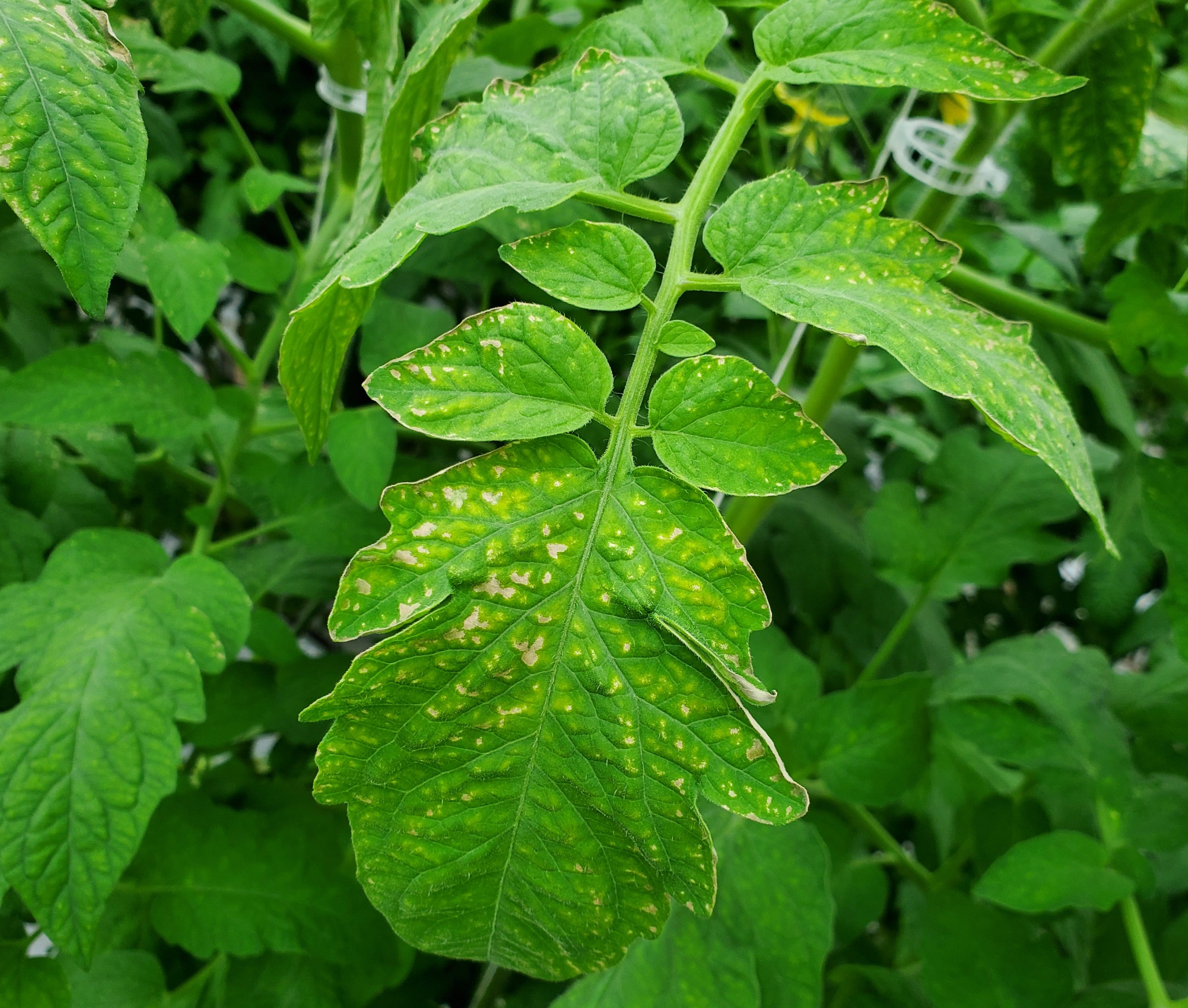
Features
Fertilizer
Vegetables
Interpreting summer EC readings
Diagnosing crop problems from afar using greenhouse data, EC and photos - a case study in tomatoes.
June 8, 2020 By Dr. Mohyuddin Mirza

COVID-19 has changed the way I do extension and diagnostics. Visiting greenhouses is almost impossible, so the use of digital methods has increased. However, when somebody sends photos to me, the answer is often not a simple ‘yes,’ it is a deficiency, toxicity or other reasons.
In this case study, the grower sent photos and mentioned leaf symptoms, which can be described as scorching, magnesium deficiency, mosaic, and puckering (see photos). The cluster set also had very weak, very pale flowers.
Did you know that tomato plants produce three sets of leaves and one cluster per week? Under optimum light and temperature conditions, I have seen two leaves and one cluster as well. It all depends on plant energy balance. I asked the grower to send me information on feed and leach EC, the past week’s day and night temperatures, any sprays, and any other facts relating to location. It was pointed out that symptoms are more prevalent on the south side compared to the north side of the greenhouse. After a few more emails, I finally received the data on pH, EC, light, average temperatures, sprays and any other foliar applications.
It took two days to get the data summarized (see table). This means that the grower was not keeping regular data and it had to be “dug out” for those days when symptoms appeared.

The day and night temperatures and 24-hour averages were within the 18.5°C to 21°C range. I concluded that the EC was high in relation to light intensity and therefore created water stress related to high osmotic pressure. The roots’ uptake of water could not keep up with the transpiration demands of the leaves. We ruled out possible magnesium deficiency after reviewing the fertilizer program.
Looking at the data, leach EC was higher on the south side of the greenhouse compared to the north side, even though the same nutrient solution was used. This happens because of relatively higher light levels on the south side of the greenhouse, and thus more water is transpired and the leaf temperature is higher. As a result, plants take up more water for cooling and nutrients build up in the growing medium. Many growers put two drippers per plant on the south side.
Ensuring accurate EC measurements
I think every grower should have a good quality pH and EC meter that is calibrated and maintained regularly. I have seen batteries that are not replaced in time, which may give incorrect readings. If you have a meter, then you must use it every day or at least every other day. EC is not just a reading of the electrical conductivity of a solution, it is a good tool for managing the fertility of your crops.
Many problems can be solved if regular data is recorded and monitored along with plant growth. Growers must also understand the “language” of the plants. Plants can tell you lot of things, but you must be able to understand what they are trying to tell you. Happy plants vs. not-so-happy plants – we should be able to see it and comprehend it.
Simply stated, EC measures how well a liquid or fluid is conducting electrical current and is commonly reported in units such as Siemens, milliSiemens, millimhos, and micromhos/cm. All it is is a number, and we interpret what this number means – low, medium, or high – in relation to the crop and stage of growth.
Why is EC useful?
Electrical conductivity measurements are very useful in greenhouse production, because:
- We can measure the EC of a solution easily and quickly using affordable sensors.
- The EC is proportional to the total amount of fertilizer salts present in a solution. It is important to note that EC indicates the total amount of fertilizer ions (nitrogen, phosphorus, and so on) but does not differentiate between them.
- EC is not a substitute for conducting a full nutrient analysis to understand what is happening inside the plant.
- EC values can be used to create stress on the plants to steer them in a vegetative or generative direction.
Are there recommended EC values?
Recommended EC values change primarily with light conditions. The rule of thumb is, the higher the light, the lower the EC of the feed and leach solution. As an example with tomatoes, EC values for seedlings without supplemental light early in the season can be as high as 6 mmhos/cm. This is achieved by using potassium sulfate. This results in a very compact plant and better energy balance. If higher EC values are not used in growing seedlings, then under low light conditions, the seedling can stretch and result in a very weak plant.
Once the seedlings are planted in the greenhouse, then the EC of the feed solution is slowly brought down. Once the first fruit starts sizing up, then the EC values should be closer to 3.0 mmhos.
How to increase or decrease EC
It is very important to remember how we increase or decrease EC in feed solutions. To decrease EC, most growers do it by increasing the injector dilution ratio. For example, if your standard ratio is 1:100, then the dial is set at 1:128 to dilute the nutrients, and thus EC goes down. The problem is that all the microelements will also be reduced and sometimes significantly. One element in particular is molybdenum. It is already in the smallest amounts and calculated to provide adequate levels at 1:100. When diluted to 1:128 it is reduced to deficient levels. Be aware of this point when reducing the EC.
To increase EC, my recommendation is to use potassium sulfate. Potassium is easily absorbed and stored in cells, and sulfates are highly leachable.
Going back to the original case study, I recommended that the grower start applying pH-adjusted water between noon and 4 pm when light levels are very high. Increasing overall leach percentage is also an option.
Take care this year. You are providing a valuable service in delivering fresh vegetables to consumers, and each kg/m2 is important.
Mohyuddin Mirza, PhD, is an industry consultant in Alberta. He can be reached at drmirzaconsultants@gmail.com
Print this page

